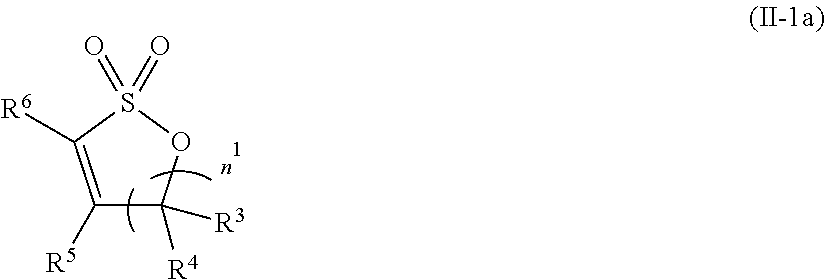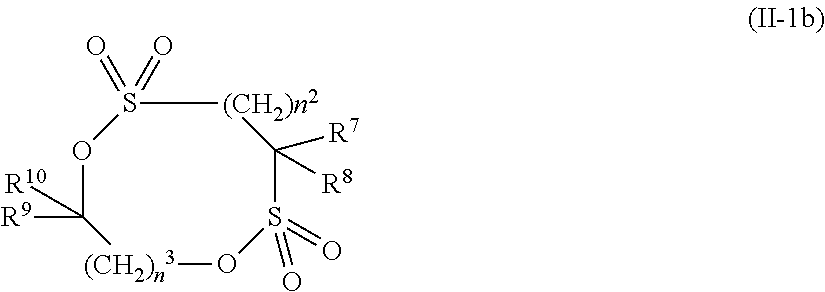Electrolytic Solution for Nonaqueous Electrolytic Solution Battery, and Nonaqueous Electrolytic Solution Battery Using Same
- Summary
- Abstract
- Description
- Claims
- Application Information
AI Technical Summary
Benefits of technology
Problems solved by technology
Method used
Image
Examples
examples
[0121]The present invention will be described in more detail below by way of the following examples. These examples are however not intended to limit the present invention thereto.
[0122]
[0123]Each electrolytic solution was prepared by the following procedure using, as a nonaqueous solvent, a mixed solvent of ethylene carbonate (hereinafter referred to as “EC”), propylene carbonate (hereinafter referred to as “PC”), dimethyl carbonate (hereinafter referred to as “DMC”) and ethyl methyl carbonate (hereinafter referred to as “EMC”) at a volume ratio of 2:1:3:4.
[0124](Electrolytic Solutions No. 1-1 to 1-41 and Comparative Electrolytic Solutions No. 1-1 to 1-18)
[0125]The electrolytic solutions No. 1-1 to 1-41 and the comparative electrolytic solutions No. 1-1 to 1-18 were each prepared by dissolving, in the above mixed solvent, 1.0 mol / L of lithium hexafluorophosphate (hereinafter referred to as “LiPF6”) as a solute and further dissolving predetermined amounts of the components (I) and (...
examples 1-1 to 1-58
and Comparative Examples 1-1 to 1-43
[0179]Evaluations of Nonaqueous Electrolyte Batteries
[0180] High-temperature storage characteristics (70° C.)
[0181]The following evaluation was performed on each of the nonaqueous electrolyte batteries of Examples 1-1 to 1-58 and Comparative Examples 1-1 to 1-43.
[0182]First, the above-obtained cell was subjected to conditioning treatment under the following conditions at an ambient temperature of 25° C. The cell was initially charged by constant-current constant-voltage charging with a charging upper limit voltage of 4.3 V at a 0.1C rate (3 mA). Subsequently, the cell was discharged to a discharge termination voltage of 3.0 V by constant-current discharging at a 0.2C rate (6 mA). After that, the cell was subjected to three cycles of constant-current constant-voltage charging with a charging upper limit voltage of 4.3 V at a 0.2C rate (6 mA) and constant-current discharging to a discharge termination voltage of 3.0 Vat a 0.2C rate (6 mA).
[0183]Afte...
examples 2-1 to 2-47
and Comparative Examples 2-1 to 2-13
[0207]Production and Evaluation of Nonaqueous Electrolyte Batteries
[0208]Nonaqueous electrolyte batteries of Examples 2-1 to 2-47 and Comparative Examples 2-1 to 2-13 were produced in the same manner as the nonaqueous electrolyte battery of Example 1-1 by providing aluminum laminate-packed cells (capacity 30 mAh), each of which had a NCM positive electrode for testing, a graphite negative electrode for testing and a separator of cellulose, and respectively impregnating the aluminum laminate-packed cells with the electrolytic solutions No. 2-1 to 2-47 and the comparative electrolytic solutions No. 2-1 to 2-13 listed in TABLES 6 and 7.
[0209]The following evaluations were performed on these nonaqueous electrolyte batteries in the same manner as in Example 1-1.
[0210] High-temperature storage characteristics (70° C.)
[0211] Gas generation amount during high-temperature storage (70° C.)
[0212]In TABLE 8, the results of the evaluations ( and ) of the nonaq...
PUM
 Login to View More
Login to View More Abstract
Description
Claims
Application Information
 Login to View More
Login to View More - R&D
- Intellectual Property
- Life Sciences
- Materials
- Tech Scout
- Unparalleled Data Quality
- Higher Quality Content
- 60% Fewer Hallucinations
Browse by: Latest US Patents, China's latest patents, Technical Efficacy Thesaurus, Application Domain, Technology Topic, Popular Technical Reports.
© 2025 PatSnap. All rights reserved.Legal|Privacy policy|Modern Slavery Act Transparency Statement|Sitemap|About US| Contact US: help@patsnap.com



